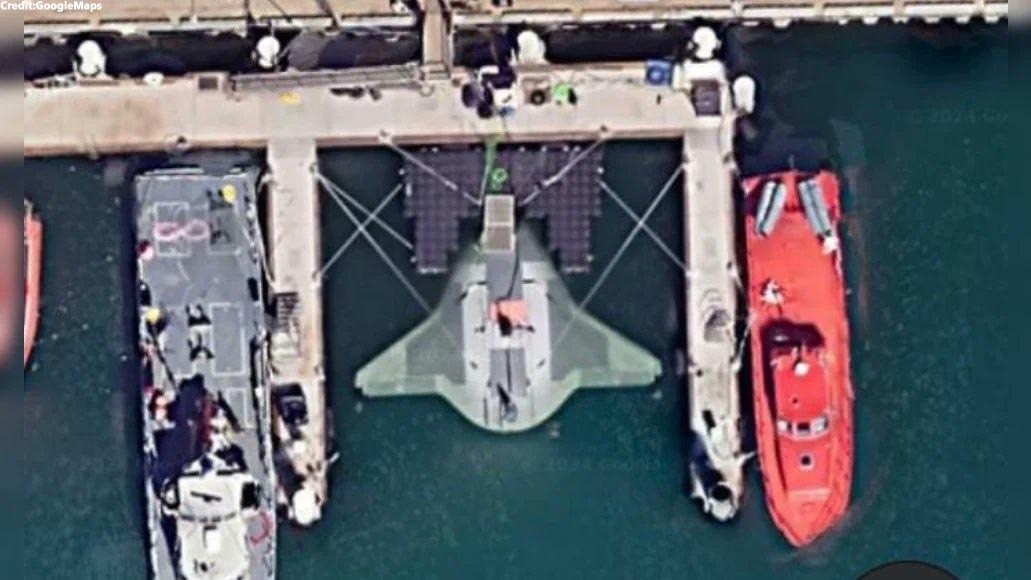Defence
Google Maps Exposes Secret US Naval Drone ‘Manta Ray’

Internet users were recently taken by surprise when they discovered an unusual sight on Google Maps: a US naval submarine drone called the ‘Manta Ray’ docked at Port Hueneme naval base in California.
US naval submarine drone ‘Manta Ray’ spotted
This sighting stirred a mix of curiosity and concern, leading many to question whether this was a deliberate reveal or a security oversight. Soon after, the image was replaced with that of a normal ship, adding to the mystery.
The Manta Ray submarine drone is a sophisticated piece of technology designed to remain underwater for extended periods. Equipped with advanced sensors, it is capable of detecting underwater threats and hibernating on the sea floor without the need for frequent refueling. This unique drone uses buoyancy to glide seamlessly through the water, both below and above the surface.
One of the standout features of the Manta Ray is its modular design, allowing it to be disassembled and transported in standard shipping containers. This eliminates the necessity for dedicated port facilities, making its deployment more flexible and efficient. The modular design enables the Manta Ray to be reassembled and deployed in various locations as needed.
Built by Northrop Grumman for a US Navy project
Built by Northrop Grumman as part of a US Navy project, the Manta Ray represents a significant advancement in underwater warfare technology. The project aims to develop long-range underwater weapons, with the Manta Ray at the forefront. The drone’s ability to hibernate on the seafloor for extended periods without refueling highlights its potential for long-term, covert operations.
The Manta Ray is designed with several payload bays of varying sizes, allowing it to undertake a wide range of naval missions. Despite its name suggesting a creature of the sea, the Manta Ray drone seemed to vanish from the internet as quickly as it appeared, leaving many to speculate about the true nature and capabilities of this top-secret aquatic weapon.
Adding to the intrigue, reports suggest that the Manta Ray’s adversary boasts a drone with a range of about 6,200 miles, capable of reaching speeds up to 100 knots (approximately 115 mph) and potentially being armed with nuclear weapons. This revelation underscores the high stakes and cutting-edge technology involved in modern naval warfare.

Defence
Russia’s NV.17 Hybrid Helicopter Aims to Balance Light and Heavy Helicopter Needs

As Western sanctions continue to impact Russia’s aviation sector, the country is making significant strides in advancing its domestic aerospace capabilities.
Despite the ongoing challenges, Russia has unveiled the Heliburo HB.17, a cutting-edge hybrid-powered medium-class helicopter that promises to reshape both commercial and military aviation.
The helicopter is currently in the technical design phase, with plans for its first flight slated for 2027. This marks a major step forward in Russia’s efforts to modernize its aviation fleet and reduce reliance on foreign technology.
This country tops visa rejections in the popular Schengen countries
The HB.17 is designed as a versatile, multi-role aircraft, capable of performing a wide range of functions. It is built to handle cargo transport, passenger carriage, reconnaissance, and close air support missions. With its robust design and flexible capabilities, the HB.17 is expected to meet the needs of both military and commercial operators, offering a solution for missions requiring a greater capacity than light helicopters but avoiding the limitations of larger aircraft.
One of the most innovative features of the HB.17 is its hybrid power plant. This combination of conventional and electric technologies enhances fuel efficiency, allowing the helicopter to stay airborne for up to seven hours without needing to refuel.
This extended operational endurance makes the HB.17 particularly well-suited for long-duration missions, providing a significant advantage over traditional helicopters. Additionally, the HB.17 will be equipped with modern avionics, ensuring advanced navigation, communication, and operational capabilities.
Qatar Airways Cargo and MASkargo Launch New Strategic Partnership
The HB.17 is positioned to compete with other medium-class helicopters such as the Kamov Ka-60/62 and the Mil Mi-38. However, its hybrid powerplant and modern avionics set it apart, offering a more efficient and technologically advanced alternative.
Its multi-role versatility, combined with its fuel efficiency and cutting-edge systems, gives it a competitive edge in the evolving aviation landscape. The introduction of the HB.17 follows recent reports of Russia receiving a new batch of armored vehicles from the UAE-based Streit Group.
Russia has traditionally focused on producing helicopters for defense purposes, but this time, it appears to be venturing into the civilian helicopter market with the HB.17.
This, along with the ongoing development of the HB.17, reflects Russia’s continued efforts to modernize its military assets and increase its self-reliance, even as sanctions continue to pressure its defense and aerospace sectors.
As Russia faces mounting geopolitical challenges, the HB.17 stands as a symbol of resilience, technological innovation, and determination to maintain its military and aviation capabilities.
-

 Aviation2 months ago
Aviation2 months agoMicrosoft Flight Simulator Raises $3 Million to Bring Back the An-225 Mriya
-

 Airlines2 months ago
Airlines2 months agoQatar Citizens Can Travel to the United States Without a Visa
-

 Aviation2 months ago
Aviation2 months agoQatar Airways bans these new Electronic Devices on plane
-

 Airlines2 months ago
Airlines2 months agoJapan Airlines Rolls Out Free Domestic Flights to International Passengers
-

 Travel2 months ago
Travel2 months agoQatar Airways Launches Four Additional Flights from Amsterdam
-

 Defence2 months ago
Defence2 months agoWhich Country Has the Largest Fleet of Fighter Aircraft?
-

 Airport2 months ago
Airport2 months agoWestern Sydney Airport Welcomes Its First Plane After 6 Years of construction
-

 Airlines4 days ago
Airlines4 days agoDAMAC Air: Dubai’s New Luxury Airline Offers Free Flights for Registration








